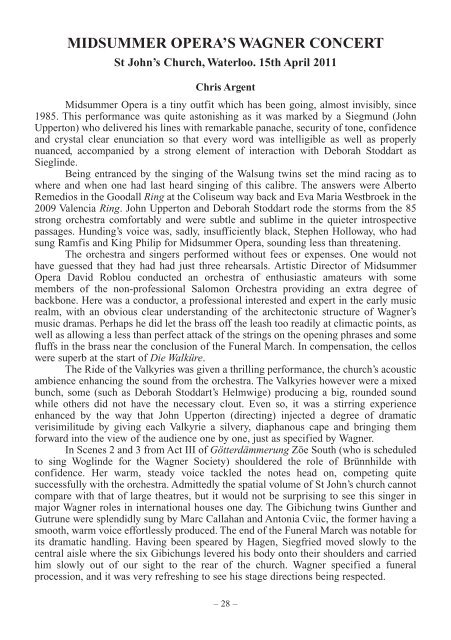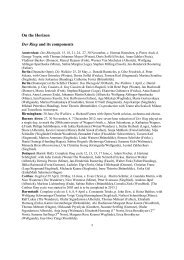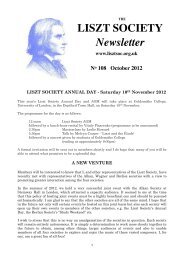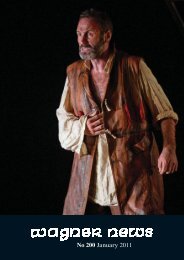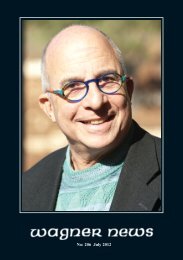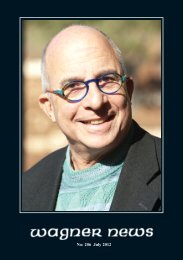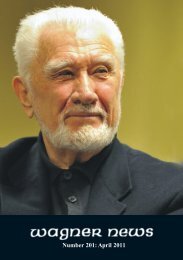Number 202: July 2011 - Wagner Society of England
Number 202: July 2011 - Wagner Society of England
Number 202: July 2011 - Wagner Society of England
You also want an ePaper? Increase the reach of your titles
YUMPU automatically turns print PDFs into web optimized ePapers that Google loves.
MIDSUMMER OPERA’S WAGNER CONCERT<br />
St John’s Church, Waterloo. 15th April <strong>2011</strong><br />
Chris Argent<br />
Midsummer Opera is a tiny outfit which has been going, almost invisibly, since<br />
1985. This performance was quite astonishing as it was marked by a Siegmund (John<br />
Upperton) who delivered his lines with remarkable panache, security <strong>of</strong> tone, confidence<br />
and crystal clear enunciation so that every word was intelligible as well as properly<br />
nuanced, accompanied by a strong element <strong>of</strong> interaction with Deborah Stoddart as<br />
Sieglinde.<br />
Being entranced by the singing <strong>of</strong> the Walsung twins set the mind racing as to<br />
where and when one had last heard singing <strong>of</strong> this calibre. The answers were Alberto<br />
Remedios in the Goodall Ring at the Coliseum way back and Eva Maria Westbroek in the<br />
2009 Valencia Ring. John Upperton and Deborah Stoddart rode the storms from the 85<br />
strong orchestra comfortably and were subtle and sublime in the quieter introspective<br />
passages. Hunding’s voice was, sadly, insufficiently black, Stephen Holloway, who had<br />
sung Ramfis and King Philip for Midsummer Opera, sounding less than threatening.<br />
The orchestra and singers performed without fees or expenses. One would not<br />
have guessed that they had had just three rehearsals. Artistic Director <strong>of</strong> Midsummer<br />
Opera David Roblou conducted an orchestra <strong>of</strong> enthusiastic amateurs with some<br />
members <strong>of</strong> the non-pr<strong>of</strong>essional Salomon Orchestra providing an extra degree <strong>of</strong><br />
backbone. Here was a conductor, a pr<strong>of</strong>essional interested and expert in the early music<br />
realm, with an obvious clear understanding <strong>of</strong> the architectonic structure <strong>of</strong> <strong>Wagner</strong>’s<br />
music dramas. Perhaps he did let the brass <strong>of</strong>f the leash too readily at climactic points, as<br />
well as allowing a less than perfect attack <strong>of</strong> the strings on the opening phrases and some<br />
fluffs in the brass near the conclusion <strong>of</strong> the Funeral March. In compensation, the cellos<br />
were superb at the start <strong>of</strong> Die Walküre.<br />
The Ride <strong>of</strong> the Valkyries was given a thrilling performance, the church’s acoustic<br />
ambience enhancing the sound from the orchestra. The Valkyries however were a mixed<br />
bunch, some (such as Deborah Stoddart’s Helmwige) producing a big, rounded sound<br />
while others did not have the necessary clout. Even so, it was a stirring experience<br />
enhanced by the way that John Upperton (directing) injected a degree <strong>of</strong> dramatic<br />
verisimilitude by giving each Valkyrie a silvery, diaphanous cape and bringing them<br />
forward into the view <strong>of</strong> the audience one by one, just as specified by <strong>Wagner</strong>.<br />
In Scenes 2 and 3 from Act III <strong>of</strong> Götterdämmerung Zöe South (who is scheduled<br />
to sing Woglinde for the <strong>Wagner</strong> <strong>Society</strong>) shouldered the role <strong>of</strong> Brünnhilde with<br />
confidence. Her warm, steady voice tackled the notes head on, competing quite<br />
successfully with the orchestra. Admittedly the spatial volume <strong>of</strong> St John’s church cannot<br />
compare with that <strong>of</strong> large theatres, but it would not be surprising to see this singer in<br />
major <strong>Wagner</strong> roles in international houses one day. The Gibichung twins Gunther and<br />
Gutrune were splendidly sung by Marc Callahan and Antonia Cviic, the former having a<br />
smooth, warm voice effortlessly produced. The end <strong>of</strong> the Funeral March was notable for<br />
its dramatic handling. Having been speared by Hagen, Siegfried moved slowly to the<br />
central aisle where the six Gibichungs levered his body onto their shoulders and carried<br />
him slowly out <strong>of</strong> our sight to the rear <strong>of</strong> the church. <strong>Wagner</strong> specified a funeral<br />
procession, and it was very refreshing to see his stage directions being respected.<br />
– 28 –


